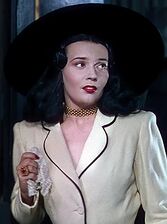Gylian presidential election, 1968
| |||||||||||||||||
| Turnout | 95,1% | ||||||||||||||||
|---|---|---|---|---|---|---|---|---|---|---|---|---|---|---|---|---|---|
| |||||||||||||||||
File:Gylias-elections-presidential-1967-final.png | |||||||||||||||||
| |||||||||||||||||
Presidential elections were held in Gylias on 22 February 1967.
Incumbent Eiín Dairyn was re-elected, defeating Ludmila Canaşvili, who was supported jointly by the Centre Group and Union for a New Republic. Both candidates enjoyed notable support from famous artistic figures during the election, and Ludmila was the first presidential candidate to make foreign policy an issue, promising to support Karvelebi independence in the Zemplen Conflict.
Procedure
The election is held through instant-runoff voting.
Candidates are registered with Elections Gylias in accordance with normal procedures. They could either be nominated by a political party or electoral bloc, civic organisations, or self-nomination as independents.
Candidates
| Candidate | Nominator | Office(s) held | Details | ||
|---|---|---|---|---|---|
| Eiín Dairyn | File:EiínDairyn.jpg | Independent | President of Gylias (since 1958) |
Campaigned on promotion of the arts and culture. | |
| Ludmila Canaşvili | 
|
Centre Group–Union for a New Republic | None | Campaigned on promotion of socialised luxury, polymathism, and support for Zemplen independence. | |
| Ser Şanorin | 
|
Independent | Senator for Tomes (since 1962) |
Campaigned on promotion of aristerokratia. | |
| Violet Bonham | 
|
Liberal Union | None | Campaigned as the main liberal candidate. | |
| Maria Elena Durante | 
|
Movement for Emancipation and Democracy–New People's Party | Senator for Ḑarna (since 1962) |
Campaigned on promotion of economic nationalism and left-wing populism. | |
| Françoise Chatelain | 
|
OMFLG–ACFEN | None | Campaigned on promotion of francité. | |
| Luiza Monteira | 
|
Centre of Constitutional Monarchists | None | Campaigned on promotion of monarchism. | |
Results
| Candidate | Nominator | First count | % | Final count | % | |
|---|---|---|---|---|---|---|
| Eiín Dairyn | Independent | 1.832.096 | 34,4% | 2.558.970 | 52,8% | |
| Ludmila Canaşvili | CG–UNR | 889.419 | 16,7% | 2.287.564 | 47,2% | |
| Ser Şanorin | Independent | 740.295 | 13,9% | |||
| Violet Bonham | LU | 665.733 | 12,5% | |||
| Maria Elena Durante | MED–NPP | 575.193 | 10,8% | |||
| Françoise Chatelain | OMFLG–ACFEN | 410.091 | 7,7% | |||
| Luiza Monteira | CCM | 149.124 | 2,8% | |||
| Others/write-ins | 63.910 | 1,2% | ||||
| Total | 5.325.861 | 100% | 4.846.534 | 100% | ||
| Registered voters and turnout | 5.662.563 | 95,1% | ||||
Maps
Analysis
In contrast to the unique circumstances of the previous election, some realignments took place. The most significant was that Eiín Dairyn had enjoyed support from centre and centre-right voters in 1961, running against a Progressive Alliance candidate, but was identified more with the centre-left in this election. The Progressive Alliance chose not to field a candidate, tacitly supporting Eiín for re-election.
In the first count, Eiín improved on her 1961 performance, winning 6% more first preference votes. Violet Bonham won pluralities in Arxaþ, Alţira, and Elena, cementing their status as Liberal Union strongholds. Ser Şanorin performed very well in Mişeyáke and Nezyál, and finished third overall. Maria Elena Durante campaigned heavily in northern Gylias, and won pluralities in Salxar, Makarces, Gacar, and Gerşyr.
Both Eiín and Ludmila were identified with arts and culture, attracting heightened attention and support from Gylias' artistic scenes. Ludmila also highlighted her Karvelebi identity during her campaign, creating one PPB that showed her travelling to Ruvelka and arguing for Zemplen independence, criticising Syara's occupation of Zemplen. She conducted a whistle-stop campaign, travelling standing up on a landaulette and wearing the "Mila suit" she'd wore in The Red Shoes, which helped attract large crowds to her events.
In the final count, Eiín largely gained vote transfers from Maria Elena's voters, while Ludmila received the most transfers from Françoise and Luiza's voters. Françoise voters overwhelmingly backed Ludmila in second preferences, as she had made a point of not using English in her campaign. Transfers from Ser were mostly evenly split, since both Eiín and Ludmila could be identified with aristerokratia. Although Violet ran a centre-left campaign, her voters' preferences unexpectedly transferred more to Ludmila.
Ludmila won Nerveiík-Iárus-Daláyk, the most populated region, in the final count, and took much of southern and western Gylias, plus Violet's regions. However, her overall performance compared to 1961 was mixed: she won more votes than Maléna Laryn, and tied Eiín for regions carried, but her 47,2% on the final count fell short of Maléna's 48,9%.
Columnist Denise Sarrault jokingly dubbed the final result "a contest between a white hat and black hat", in reference to Eiín and Ludmila's usual wardrobe.
